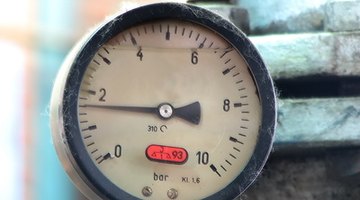Homemade Water Pressure Tank for a Well
Table of Contents
All home well systems come with a pressure tank which serves as water storage, provides the pressure to move the water through the plumbing system the well services and regulates the number of times the well pump has to be turned on to keep the system charged.

Pressure tanks are available commercially in a variety of sizes but in the end, any barrel, boiler or other steel container capable of safely handling the pressure of the water system can be constructed at home to become a pressure tank.
Size
The size of the tank needed to make the pressure tank is determined by the size of the plumbing system the tank will serve. A small system for a garden sprinkler or a one-bathroom home can be made from a 10-gallon tank. A large home with several bathrooms and the potential for several people to be using the water system simultaneously would be better served by a tank as large as 50 gallons.
Used Tanks
Few tanks made for other uses adapt perfectly for use as a water system pressure tank, but there are many possibilities for sources of acceptable tanks. Any tank of any shape capable of handling internal pressure of 60 to 80 pounds psi can be used. Discarded oxygen or inert welding gas cylinders, well cleaned propane cylinders, the inner tank from a water heater or used furnace boilers are all possibilities. Standard steel 30- or 55-gallon barrels won’t safely handle the pressure most water systems deliver.
Seal it Up
Whatever sort of tank you acquire, chances are it will have one or several bungs, holes or outlets. Chances are, none will be located or sized correctly for your needs. Seal them up using pipe plugs if they are tapped to National Pipe Thread (NPT) standards or just weld them shut to insure you have a water and air tight tank.
Fabrication
Check the size of the output hole on the water pump used to extract water from the well. Most are either 1-inch or 3/4-inch NPT. At or near the bottom of the tank, cut a hole of the appropriate size to fit either a 3/4- or 1-inch bushing to match the pump outlet. Weld around the perimeter of the bushing so the pipe from the pump to the tank can be installed.
At or near the top of the tank install an air valve stem with a 1/4-inch NPT base. The female part of this attachment can either be tapped if the wall of the tank is 3/16 inch thick or more or another bushing can be welded into the side of the tank to accept the valve stem.
Rust
Well water tanks are subject to condensation on the exterior in most climates. Fabricate a stand or legs on the tank to elevate it a few inches off the floor to allow the condensation to run down and drip off. A coating of rust-resistant paint on the exterior will add longevity to the tank.
The Drip Cap
- All home well systems come with a pressure tank which serves as water storage, provides the pressure to move the water through the plumbing system the well services and regulates the number of times the well pump has to be turned on to keep the system charged.
- The size of the tank needed to make the pressure tank is determined by the size of the plumbing system the tank will serve.
- Few tanks made for other uses adapt perfectly for use as a water system pressure tank, but there are many possibilities for sources of acceptable tanks.
- Most are either 1-inch or 3/4-inch NPT.
- The female part of this attachment can either be tapped if the wall of the tank is 3/16 inch thick or more or another bushing can be welded into the side of the tank to accept the valve stem.
References
Resources
Writer Bio
Mike Schoonveld has been writing since 1989 with magazine credits including "Outdoor Life," "Fur-Fish-Game," "The Rotarian" and numerous regional publications. Schoonveld earned a Master Captain License from the Coast Guard. He holds a Bachelor of Science in wildlife science from Purdue University.
Photo Credits
- pressure-gauge image by Dusan Radivojevic from Fotolia.com
- pressure-gauge image by Dusan Radivojevic from Fotolia.com
More Articles



